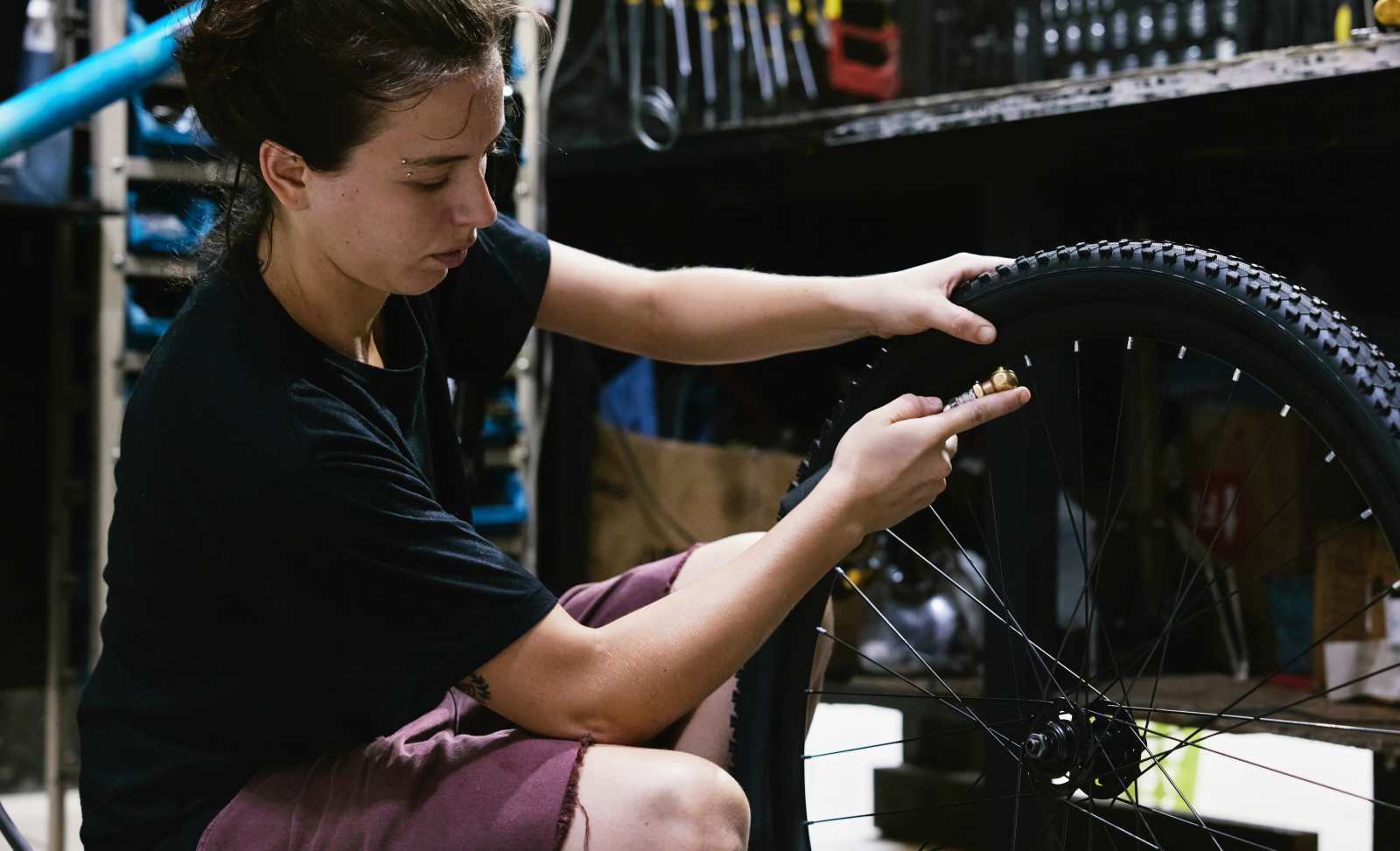Maximize your riding experience: Why tire pressure is crucial for e-bikes and bicycles

18 Juni
·
Knowledge

Tire pressure plays a critical role in the performance, comfort and safety of bicycles and e-bikes. In this blog post, we will explore the effects of under- and over-inflation and highlight the importance of optimal pressure.
`
Optimal tire pressure improves performance, reduces rolling resistance and increases efficiency. It also affects comfort by absorbing shock and making the driving experience more pleasant. However, incorrect pressure can lead to problems such as poor traction and loss of control.
`
Learn more about the differences between under- and over-inflated tires and how to find the best pressure for your bike or e-bike to optimize your performance, comfort and safety.
The effects of tire pressure
Tire pressure plays a decisive role in the handling and performance of bicycles and e-bikes. One aspect that stands out in particular is rolling resistance. The tire pressure directly influences the resistance when riding and thus the efficiency of the vehicle. Too low a pressure leads to increased rolling resistance, which means that more energy has to be applied to make progress. This reduces efficiency, especially over longer distances or at higher speeds. Optimal tire pressure, on the other hand, minimizes rolling resistance and maximizes the efficiency of your bike.
`

`
Another important aspect is traction. Tire pressure has a direct impact on the grip of your tires on different surfaces and in different weather conditions. Underinflation reduces traction, especially on wet or slippery roads. This can lead to an increased risk of slippage or loss of control. Optimal tire pressure, on the other hand, ensures good grip and improves safety during braking, acceleration and cornering.
`
Last but not least, tire pressure also affects ride comfort. Optimal pressure can help dampen shocks and vibrations and thus improve the driving experience. Underinflation leads to a spongy ride, as the tire does not provide enough support. This can lead to an uncomfortable ride and impaired control of the bike. With an optimal tire pressure, on the other hand, shocks are better absorbed and the riding experience becomes more pleasant. It becomes clear that tire pressure has a significant impact on the rolling resistance, traction and ride comfort of bicycles and e-bikes. By choosing the right pressure, you can optimize performance and efficiency, improve grip on different surfaces and enjoy a pleasant riding experience with minimized shocks and vibrations.
The correct method for determining tire pressure
The correct method of determining tire pressure is critical to ensure optimum performance and safety. First, the manufacturer's specifications should be followed. Each tire has specific manufacturer recommendations for optimal pressure. You can usually find this information on the tire sidewall or in the owner's manual. It is important to consider these values as they are based on the specific characteristics of the tire.
`
Another factor to consider when determining tire pressure is the weight of the rider and load. The more weight on the bike or e-bike, the higher the tire pressure should be to ensure adequate support and stability. It is advisable to use the manufacturer's recommendations as a starting point and adjust the pressure as necessary to account for individual weight and loading.
`
A hands-on demonstration to check and adjust tire pressure can be helpful. Use a pressure gauge to read the current pressure. Begin by checking the pressure on both tires and making sure it meets the manufacturer's specifications. If adjustments are needed, use a suitable air pump to gradually increase or decrease the pressure. Recheck the pressure to make sure it is within the recommended range. Repeat this process regularly to keep the tire pressure at the optimum level.
`
By using the proper method to determine tire pressure and considering manufacturer specifications, weight factors and hands-on demonstrations, you can ensure your tires are at the optimal pressure. This will help you achieve maximum performance, best grip and a pleasant riding experience, while ensuring safety on or off the road.
Tire pressure recommendation for e-bikes and bicycles
When it comes to specific tire pressure recommendations, there are some important points to consider. For road bikes such as road bikes and touring bikes, the recommended pressure ranges are generally between 6 and 8 bars (90-120 psi). These values can vary depending on tire width and rider weight. It is advisable to stick to the lower end of the recommended pressure range to ensure good rolling resistance and sufficient comfort.
`
For mountain bikes, there are differences in tire pressure depending on the type of mountain biking. For cross-country bikes, a slightly higher pressure in the range of 2.5 to 3.5 bar (35-50 psi) is often recommended to provide low rolling resistance and good traction. For enduro bikes, the pressure can be slightly lower, around 1.8 to 2.5 bar (25-35 psi), to provide better cushioning and traction on technical terrain. For downhill bikes with wide tires, the pressure can be even lower, about 1.6 to 2.2 bar (23-32 psi), to provide maximum traction and shock absorption.
`
For e-bikes, there are special considerations due to the added weight of the battery and motor. Here, a slightly higher tire pressure is often recommended to compensate for the extra weight and ensure good stability. The exact recommendations may vary depending on the e-bike model, so it is important to follow the manufacturer's instructions. In general, the recommended pressure range for e-bikes is between 3.5 and 4.5 bars (50-65 psi), but can vary slightly depending on tire width and rider weight.
`
By following the specific tire pressure recommendations for your bike or e-bike, you can ensure that you enjoy the optimal riding experience. Be sure to check and adjust pressure regularly to maximize performance, comfort and safety on your rides.
What happens if my tire pressure deviates from the optimal tire pressure?
It is important to maintain the optimum tire pressure for your bike or e-bike, as deviations from this value can have noticeable effects. If the tire pressure is too low, the rolling resistance increases. This means you have to expend more energy to move forward, resulting in reduced efficiency. Additionally, underinflation can affect traction on different surfaces and in different weather conditions. You risk a spongy feel, poorer control, and an increased risk of punctures, especially when riding over rough terrain.
`
On the other hand, overinflating your tires can also have negative effects. Overinflation reduces ride comfort by reducing the tire's ability to absorb shock and vibration. This can lead to an uncomfortable driving experience, especially on rough roads or when crossing obstacles. In addition, too much pressure can affect the grip and control of the bike or e-bike. The tires may have less grip on the road or in curves, which increases the risk of slipping or falling. In addition, the risk of tire blowouts increases as the pressure may exceed the load limits of the tire.
`
It becomes clear that deviations from the optimal tire pressure can have a noticeable impact on the performance, comfort and safety of your bike or e-bike. Therefore, it is important to regularly check and adjust tire pressure to ensure the optimal riding experience. Follow the recommended pressure values, take into account your weight and type of cycling, and find the right balance to maximize efficiency as well as comfort and safety.
When do I check the tire pressure?
Regularly checking tire pressure is critical to the optimal performance and safety of your bike or e-bike. Why is it so important? Tire pressure can gradually decrease over time, due to air leaks or natural diffusion. In addition, tires can change due to external influences such as temperature fluctuations. Insufficient or excessive tire pressure affects driving characteristics and increases the risk of accidents. Therefore, it is advisable to check the tire pressure regularly and adjust it if necessary.
`
How often should I check the tire pressure? It is recommended to check the pressure at least once a month. However, more frequent checks may be required depending on driving style, route conditions and environment. For intensive use or driving on challenging terrain, it is advisable to check tire pressure more often as it can change more quickly.
`
To check tire pressure, you will need a pressure gauge, which can be easily attached to the valves of the tires. There are different types of pressure gauges, such as digital or analog versions, which are usually available at most bike repair stores or sporting goods stores. To best check the pressure, the bike or e-bike should be on a flat surface. Remove the valve cap and attach the pressure gauge to the valve. The pressure gauge will show the current pressure, which you can then compare to the recommended values. If adjustments are necessary, use a suitable air pump to gradually increase or decrease the pressure.
`
By regularly checking tire pressure and adjusting as needed, you can ensure optimal performance and safety on your rides. Use the right tools and follow the recommended intervals to ensure you are riding with the optimal tire pressure. This will allow you to enjoy a pleasant driving experience and minimize the risk of accidents or damage.
More tips and advice
In addition to the basic aspects of tire pressure, there are a few other tips and recommendations that can help you get the most out of your e-bike. If you're using tubeless tires, there are specific considerations you should keep in mind. Make sure the tire pressure is sufficient to ensure a good seal between the tire and the rim. Underinflation can cause leaks, while overinflation increases the risk of punctures. Find out the specific requirements and recommendations for tubeless tires and stick to them.
`
Also remember that tire pressure should be adjusted according to season and temperature. In colder temperatures, tire pressure usually decreases, so it's important to check it regularly and adjust it if necessary. In summer or hot conditions, on the other hand, tire pressure may increase. Be sure to adjust the pressure according to the weather conditions to ensure optimal performance and safety.
`
In the event of a flat tire on the road, it is important to know how to make temporary repairs. Always carry a patch kit, spare tube or repair fluid to seal small holes or tears. If you don't have a spare tube and need to temporarily increase tire pressure, you can do so with a CO2 cartridge or portable air pump. Conversely, you can decrease the pressure to get more traction on rough terrain or in slippery conditions. Remember that these temporary measures are only temporary and you should correct the tire pressure later.
`
By considering these additional tips and recommendations, you can further improve the riding experience with your bike or e-bike. Be aware of the specific requirements for your tires, adjust the tire pressure depending on the season and temperature, and be prepared in case of a flat tire. This way, you can ensure that you enjoy optimal comfort, grip and safety on your rides.
Conclussion
The correct tire pressure plays a crucial role in the performance, comfort and safety of bicycles and e-bikes. Both too low and too high pressure can have negative effects. Underinflation leads to increased rolling resistance, affects traction and handling, and increases the risk of punctures. Overinflation affects ride comfort, grip and control, and can lead to tire blowouts.
`
Therefore, it is important to check and adjust tire pressure regularly. Follow the manufacturer's instructions to determine recommended pressures, which can usually be found on the tire or in the owner's manual. Also consider factors such as your weight and the type of cycling you do. Handy tools like a pressure gauge make it easy to check tire pressure.
`
Regularly checking and adjusting tire pressure will ensure optimal performance and safety on your rides. You'll benefit from better efficiency, a more comfortable ride, and increased traction. By keeping your tires properly inflated, you'll also minimize the risk of accidents and punctures.
`
So take the time to check and adjust your tire pressure. It's a simple but crucial measure to get the most out of your bike and e-bike. Stick to the recommended levels, note the specific requirements for different types of bikes, and think about seasonal adjustments as well. This way, you can ensure that you are always riding with the optimal tire pressure and enjoying a pleasant, safe and efficient riding experience.
`
For more useful tips and information, check out our blog.
`
Best regards
Your Velio Team










